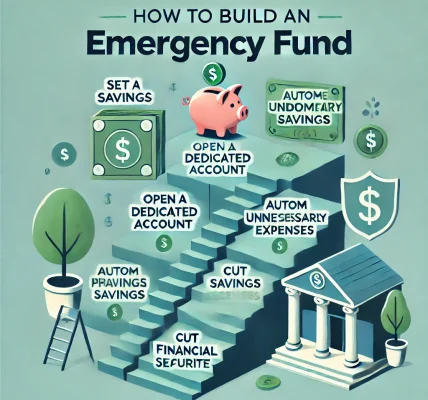In today’s fast-paced world, financial stability is crucial for a secure and stress-free life. Without a strong financial foundation, individuals may struggle with debt, lack of savings, and unpredictable financial crises. This guide will help you build a solid financial base, ensuring long-term wealth, stability, and peace of mind.
Step 1: Set Clear Financial Goals
Financial success begins with setting clear and achievable goals. Define both short-term and long-term objectives. Examples of short-term goals include saving for a vacation, paying off credit card debt, or building an emergency fund. Long-term goals may involve buying a home, funding a child’s education, or preparing for retirement.
Tips for Setting Financial Goals:
- Use the SMART method (Specific, Measurable, Achievable, Relevant, and Time-bound).
- Prioritize goals based on urgency and importance.
- Regularly review and adjust your goals as needed.
Step 2: Create a Budget and Stick to It
A well-structured budget is the backbone of financial stability. It helps track income and expenses, ensuring that you live within your means.
How to Create an Effective Budget:
- List all sources of income (salary, business, rental income, etc.).
- Track and categorize expenses (fixed expenses like rent, variable expenses like groceries, and discretionary spending like entertainment).
- Identify areas to cut unnecessary expenses.
- Allocate a portion of income towards savings and investments.
- Use budgeting apps or spreadsheets to monitor progress.
Step 3: Build an Emergency Fund
An emergency fund acts as a financial cushion during unforeseen circumstances such as medical emergencies, job loss, or urgent home repairs.
How Much Should You Save?
- Ideally, save at least 3-6 months’ worth of living expenses.
- Keep the funds in a high-yield savings account for easy access.
- Start small if necessary, but contribute regularly.
Step 4: Manage and Reduce Debt
Debt can be a major financial burden if not managed wisely. Prioritize reducing high-interest debts first, such as credit card balances.
Debt Management Strategies:
- Use the snowball method (pay off the smallest debt first for motivation) or the avalanche method (focus on the highest interest rate debt first to save money).
- Avoid accumulating unnecessary debt and use credit responsibly.
- Consider consolidating loans to lower interest rates if applicable.
Step 5: Save and Invest Wisely
Saving and investing are key components of wealth creation. While saving protects against short-term financial needs, investing ensures long-term financial growth.
Smart Saving and Investing Tips:
- Open a retirement account (e.g., 401(k), IRA) and contribute consistently.
- Diversify investments (stocks, bonds, mutual funds, real estate, etc.).
- Educate yourself about different investment options.
- Seek professional financial advice if needed.
Step 6: Improve Your Credit Score
A good credit score helps secure loans at lower interest rates and improves overall financial credibility.
Ways to Improve Credit Score:
- Pay bills on time.
- Keep credit utilization low (preferably below 30%).
- Avoid frequent loan applications.
- Check credit reports regularly and correct errors if any.
Step 7: Plan for Retirement Early
It’s never too early to plan for retirement. The earlier you start, the more you benefit from compound interest.
Retirement Planning Essentials:
- Determine retirement goals and estimate required savings.
- Contribute to retirement accounts consistently.
- Take advantage of employer-sponsored retirement plans.
- Adjust contributions as your income grows.
Step 8: Get Adequate Insurance Coverage
Insurance protects against financial risks arising from unexpected events like accidents, illnesses, or property damage.
Essential Insurance Policies:
- Health insurance
- Life insurance
- Auto insurance
- Homeowners/renters insurance
- Disability insurance
Step 9: Increase Financial Knowledge
Continuous learning is essential for making informed financial decisions.
Ways to Enhance Financial Literacy:
- Read books and articles on personal finance.
- Follow reputable financial blogs and podcasts.
- Attend financial literacy workshops or courses.
Step 10: Regularly Review and Adjust Your Financial Plan
Financial planning is an ongoing process. Regularly reviewing your budget, investments, and financial goals helps you stay on track.
How to Stay on Top of Finances:
- Assess progress toward financial goals quarterly or annually.
- Adjust investments based on market conditions and personal risk tolerance.
- Reevaluate insurance coverage and update policies if necessary.
Conclusion
Building a strong financial foundation requires discipline, consistency, and informed decision-making. By setting goals, budgeting wisely, managing debt, saving, investing, and continuously improving financial knowledge, you can achieve financial stability and long-term wealth. Start today, and take control of your financial future!


